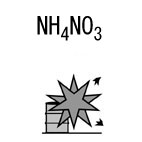| Case Name |
Explosion occurred immediately after automation of a reactor for preparing guanidine nitrate. |
| Pictograph |

|
| Date |
August 14, 1970 |
| Place |
Hiratsuka, Kanagawa, Japan |
| Location |
Chemical factory |
| Overview |
Operation started after remodeling for automatic operation from conventional manual control for manufacturing guanidine nitrate. Insufficient automation caused decomposition of raw materials and products with auto-reactivity and explosiveness. When a chemical process is changed, unforeseen circumstances can arise. In a reaction system, monitoring of temperature and pressure and ensuring emergency procedures are important. |
| Incident |
An explosion occurred at a plant that manufactured guanidine nitrate from ammonium nitrate and dicyandiamide when three workers started the reaction by putting 150 kg of ammonium nitrate and 33 kg of dicyandiamide into the reactor. |
| Processing |
Manufacture |
| Individual Process |
Reaction |
| Process Flow |
Fig2.Unit process flow
|
| Chemical Reaction |
Other |
| Substance |
Guanidine nitrate, Fig3 |
| Ammonium nitrate, Fig4 |
| Dicyandiamide. Fig5 |
| Type of Accident |
Explosion |
| Sequence |
Remodeling for automatic operation of the reactor was finished, and a trial run started at the beginning of August, 1970.
On August 7th, 1970. The thermometer for starting agitation in the reactor failed to indicate the correct temperature.
On August 12th. A thermo-well of the thermometer was repaired. There were some other problems as well.
22:00 on August 13th. Raw materials were charged into the reactor. Although agitation speed and temperature were set at an automatic mode, power was not supplied, and it was operated manually.
01:30 on August 14th. The reaction ended. When the reaction liquid was taken out, an alarm lamp informing of a high temperature lit.
05:40. The third reaction started, ending at around 08:10. The alarm lamp lit during the reaction. It was operated manually.
08:40. The fourth reaction started. Agitation seemed to have been started manually.
08:51. An explosion occurred. The control panel was in full automatic mode at this time. |
| Cause |
Accident occurred directly after insufficient automation was carried out. It caused the following failures: 1) Balance between agitation and temperature control was unstable, and automatic operations were combined with manual operations. 2) There were problems with the temperature control and an alarm system. These failures seemed to have resulted in a temperature rising in the reactor, and decomposition of ammonium nitrate and guanidine nitrate. |
| Response |
The fire was extinguished using water by the public fire brigade |
| Countermeasures |
1. Improvement in temperature measurement, temperature control, an electric circuit, and reliability.
2. Prevention of contamination by foreign material.
3. Safety distance and remote operation fixed on the basis of the characteristics of respective explosives.
4. Safety education.
5. Setting of process conditions based on prior assessment of danger. |
| Knowledge Comment |
When changing a chemical process, prior assessment of reaction danger taking the worst-case scenario into account is important. |
| Background |
The safety management system was inadequate and safety education was insufficient. In spite of producing an auto-reactive substance, prior assessment of thermal danger was insufficient. |
| Reason for Adding to DB |
Example of explosion caused due to a runaway reaction from lack of hazard assessment |
| Scenario |
| Primary Scenario
|
Poor Value Perception, Poor Safety Awareness, Inadequate Risk Recognition, Organizational Problems, Inflexible Management Structure, Insufficient Education/Training, Planning and Design, Poor Planning, Unripeness Autmatization Planning, Production, Software Production, Non-Regular Action, Change, Change of Operation Procedure, Malfunction, Poor Software, Umbalanced Operation, Secondary Damage, External Damage, Explosion, Bodily Harm, Death, 4 person died, Bodily Harm, Injury, 15 person injured, Loss to Organization, Economic Loss, Direct Manetary Damage 14 million yen
|
|
| Sources |
Fire and Disaster Management Agency. Examples of disasters at manufacturer of dangerous objects -1970. pp.450-451.
Fire and Disaster Management Agency. Outline of explosion and fire at S chemical H factory (1970)
Guanidine Nitrate Factory Explosion Labor Accident Study Investigation Committee. Investigation report on explosion hazard at S Chemical H factory. 1971
|
| Number of Deaths |
4 |
| Number of Injuries |
15 |
| Physical Damage |
Slates of a factory building blew off and a steel framework was deformed. Debris from a destroyed reactor was spread over 200-300 m. Roofs, walls, and windows of factories and houses in the neighboring area suffered damage due to a blast and debris scattered. (Guanidine Nitrate Factory Explosion Labor Accident Study Investigation Committee). 111.8 square meters of a partially two-story steel slate building and another building were completely destroyed. Nine buildings were partially destroyed. A tank lorry was damaged (Fire and Disaster Management Agency). |
| Financial Cost |
About ¥ 9 million for buildings, ¥ 16 million for machinery and equipment. There was considerable damage to houses and a factory in the adjacent area.
¥ 28 million by estimate by the property insurance rate calculation association. ¥ 14 million by Fire and Disaster Management Agency. |
| Multimedia Files |
Fig3.Chemical formula
|
|
Fig4.Chemical formula
|
|
Fig5.Chemical formula
|
| Field |
Chemicals and Plants
|
| Author |
WAKAKURA, Masahide (Kanagawa Industrial Technology Research Institute)
TAMURA, Masamitsu (Center for Risk Management and Safety Sciences, Yokohama National University)
|
|